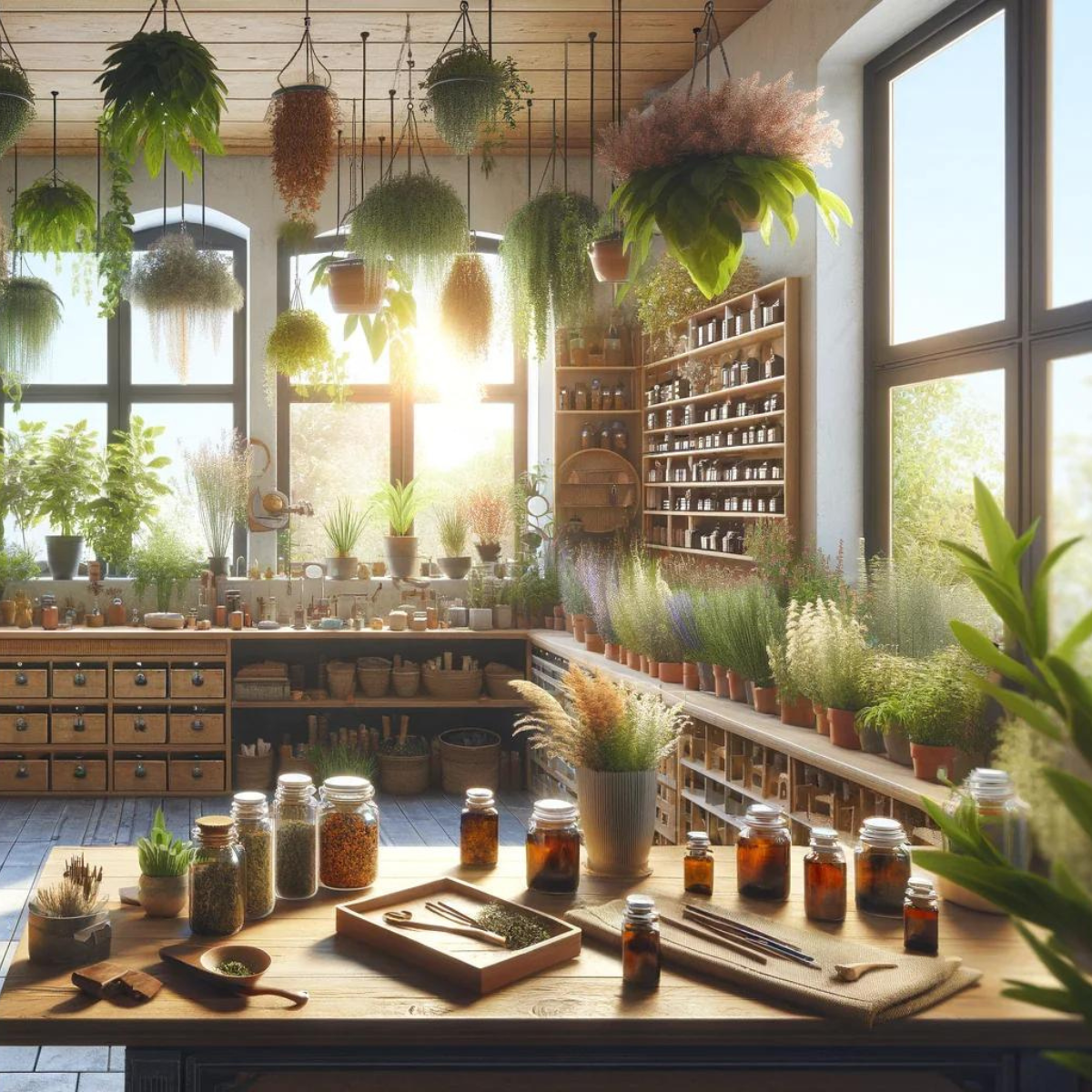Table of Contents
Introduction
Welcome to "Grow & Heal: The Guide to Naturopathic Gardening." This journey unveils the ancient wisdom of using nature's bounty for healing. At the heart of naturopathic gardening is the belief that food is more than sustenance—it's medicine. As we reconnect with the earth, we learn to cultivate plants that nourish our bodies and souls, offering natural remedies from our backyards. Join us as we explore how to transform your garden into a source of health and wellness, no matter your level of gardening experience.
The Foundations of Naturopathic Gardening
Naturopathic gardening transcends the traditional approach to gardening, embedding the philosophy of healing and nourishment into every aspect of the garden's design and care. It's about creating an ecosystem where plants do more than grow; they thrive and contribute to our well-being. Here are the core foundations that guide naturopathic gardening:
Connection with Nature
Naturopathic gardening starts with a deep respect and understanding of nature's rhythms and cycles. It's about working with nature, rather than against it, to foster a garden that supports both human and environmental health. This connection encourages us to observe the natural processes closely, learning from them to create a productive and sustainable garden.
Soil Health
The vitality of your garden begins with the soil. Healthy, nutrient-rich soil is the foundation of a naturopathic garden, supporting plant health and increasing the nutritional value of the produce. Incorporating organic matter, practising crop rotation, and using natural soil amendments are key strategies to enhance soil fertility and structure, ensuring your plants have the best possible environment to flourish.
Plant Diversity
Biodiversity is not just beneficial—it's essential for a resilient garden. A diverse array of plants encourages a balanced ecosystem, naturally reducing pests and diseases. It also maximizes the nutritional and medicinal benefits available from the garden, as different plants offer various nutrients and healing properties. Including a mix of vegetables, fruits, herbs, and flowers supports wildlife and contributes to a more nutrient-dense diet for us.
Organic Practices
To harness the full healing potential of your garden, it's important to avoid synthetic chemicals and pesticides, which can harm both the environment and your health. To maintain a healthy, vibrant garden, naturopathic gardening relies on organic practices, such as composting, mulching, and natural pest control methods. These practices ensure that the food you grow is free from harmful substances and richer in beneficial nutrients.
Sustainability and Regeneration
A naturopathic garden is designed with the future in mind, aiming to regenerate and improve with each season. This means implementing practices that conserve water, enhance biodiversity, and reduce waste, such as rainwater harvesting, planting native species, and composting. By thinking sustainably, we ensure our gardening practices contribute positively to our and the planet's health.
Food as Medicine: A Naturopathic Perspective
Naturopathic medicine has long heralded the principle that food is the most basic and powerful form of therapy. This concept is deeply woven into the fabric of naturopathic gardening, where every plant and every meal serves a purpose beyond mere sustenance. Here's how this principle comes to life:
Nutritional Powerhouses
The food we grow in our naturopathic gardens is rich in vitamins, minerals, antioxidants, and phytonutrients essential for maintaining and improving health. Focusing on nutrient-dense plants can nurture our bodies with foods tailored to support our immune system, improve digestive health, and reduce the risk of chronic diseases.
Healing Herbs and Plants
Beyond vegetables and fruits, a naturopathic garden is home to various herbs and medicinal plants with healing properties. Herbs like basil, rosemary, mint, and medicinal plants like echinacea, lavender, and chamomile can be used to create natural remedies for common ailments such as colds, anxiety, and sleep disturbances. Incorporating these plants into our gardens and diets enables us to harness their healing benefits daily.
Personalized Nutrition
Naturopathic gardening allows for the customization of the garden to meet individual health needs and preferences. By understanding the specific health benefits of different plants, gardeners can tailor their gardens to address personal or family health concerns, creating a personalized pharmacy in their backyard.
Seasonal and Local Eating
Eating seasonally and locally is a fundamental aspect of naturopathic gardening. This practice aligns our diet with the natural cycles of our environment, ensuring that we consume foods at their peak nutritional value and flavour. It also reduces the environmental impact of our food choices, supporting a more sustainable and health-focused lifestyle.
The Whole-Food Approach
In naturopathic philosophy, whole foods are superior to processed foods due to their higher nutrient content and the absence of artificial additives. By growing and consuming whole foods directly from the garden, we can enjoy the full spectrum of nutrients and benefits they offer, leading to better health outcomes.
Planning and Planting Your Naturopathic Garden
Creating a naturopathic garden requires thoughtful planning and focusing on plants offering nutritional and medicinal benefits. Here's how to begin this rewarding journey:
Assess Your Space
Start by evaluating the space available for your garden. Whether it's a small balcony with room for containers or a larger backyard plot, understanding your space helps determine what you can grow. Consider sunlight exposure, soil quality, and water access to ensure your garden's success.
Choose Your Plants Wisely
Select plants based on their health benefits, growing conditions, and compatibility with your climate. Prioritize nutrient-dense vegetables, fruits, and herbs known for their medicinal properties. Research plants that thrive in your area and consider incorporating native species to support local ecosystems.
Soil Preparation
Healthy soil is the foundation of a thriving garden. Test your soil to understand its nutrient and pH levels, then amend it with organic matter like compost to improve fertility and structure. Embrace no-till gardening methods to preserve soil health and encourage beneficial microbial activity.
Sustainable Practices
Incorporate sustainable gardening practices from the start. Utilize natural pest control methods, such as companion planting and beneficial insects, to protect your plants without harmful chemicals. Conserve water by mulching and installing a rainwater collection system if possible.
Planting with Purpose
When planting, consider each plant's specific needs in terms of spacing, depth, and companions. Some plants benefit from being grown together, offering natural pest protection or enhanced growth. Plan your garden layout to maximize space and create a harmonious environment for all your plants.
Timing is Everything
Understanding the best time to plant each type of seed or seedling is crucial. Refer to local planting calendars to align your gardening activities with the optimal growing seasons, ensuring your plants have the best chance of success.
From Garden to Table: Maximizing the Healing Potential of Your Harvest
Bringing the healing power of your naturopathic garden into the kitchen is a joyful and rewarding process. Here, the fruits of your labour can be transformed into nourishing meals, teas, and remedies that support health and wellness. Here are key strategies to maximize the healing potential of your harvest:
Harvesting with Care
It's crucial to harvest your plants at the right time to preserve their medicinal properties and nutritional value. Many herbs and vegetables are most potent when harvested in the morning after the dew has evaporated but before the sun becomes too intense. Learning the optimal harvesting time for each plant ensures you capture its peak vitality.
Preserving Freshness
Once harvested, the clock starts ticking on your produce's nutritional and medicinal quality. Quick, gentle washing and proper storage are essential to maintaining their benefits. Techniques like drying, freezing, and canning can extend the shelf life of your harvest without significantly diminishing its health properties. For instance, drying herbs preserves essential oils, while freezing vegetables locks in vitamins.
Creative and Healthful Cooking
The true magic happens when you bring your harvest to the table. Cooking with fresh, home-grown ingredients allows for creating meals that are not only delicious but also densely packed with nutrients and healing compounds. Experiment with recipes that use whole foods and minimal processing to retain the health benefits of your garden produce. Incorporating various colours and types of vegetables and herbs in your meals can ensure a broad spectrum of phytonutrients and antioxidants.
Medicinal Preparations
Beyond the kitchen, your naturopathic garden offers the raw materials for homemade medicinal preparations. Herbal teas, tinctures, salves, and poultices can all be crafted from the herbs and flowers you grow. These preparations offer natural ways to address minor ailments, from digestive issues to skin irritations, harnessing the plants' healing properties.
Mindful Eating
Maximizing the healing potential of your harvest isn't just about what you eat but how you eat. Practising mindfulness while preparing and consuming your food can enhance its nutritional benefits. Mindful eating involves savouring each bite, chewing thoroughly, and appreciating the flavours and textures of your food, which can aid digestion and absorption of nutrients.
Visit the Herb Hub
Conclusion
Embarking on the journey of naturopathic gardening transforms the simple act of gardening into a holistic health practice. Through "Grow & Heal: The Guide to Naturopathic Gardening," we've explored how integrating the principles of nature, nutrition, and mindful cultivation can turn your garden into a source of sustenance and healing. This approach nourishes the body with vital nutrients and medicinal compounds and fosters a deeper connection with the earth and our well-being.
As we've seen, the path from garden to table is filled with opportunities to enhance our health, from carefully selecting and nurturing plants to carefully preparing and consuming our harvest. Each step in this journey invites us to live more harmoniously with nature, embracing its rhythms and cycles to guide our health and wellness.
Naturopathic gardening is more than a hobby; it's a way of life that aligns with the principles of natural healing and sustainable living. It empowers us to take control of our health, one plant at a time, creating a ripple effect that extends beyond our garden to our community and the planet.
Disclaimer:
This blog post is intended for informational purposes only and should not be considered medical advice. While naturopathic gardening and utilizing food as medicine can significantly contribute to health and wellness, it's essential to consult with a healthcare professional before making any significant changes to your diet or health regimen, especially if you have existing health conditions or concerns. The information provided is based on general principles of naturopathic gardening and may not be suitable for everyone. Individual health needs and conditions should be considered with the guidance of a qualified health practitioner.
References
- Lazarou, R., & Heinrich, M. (2019). Herbal medicine: Who cares? The changing views on medicinal plants and their roles in British lifestyle. Phytotherapy Research, 33(9), 2409-2420. https://doi.org/10.1002/ptr.6431
- Ewumi, O. (2022, October 6). What is herbal medicine, and what are the benefits? Medical News Today. Medically reviewed by Kerry Boyle D.Ac., M.S., L.Ac., Dipl. Ac., CYT. Link
- Lefton, J. (2023, September 28). What Is Elderberry Good For? Verywell Health. Medically reviewed by Suzanne Fisher, RD. Fact checked by Nick Blackmer. Link
- Lubeck, B. (2023, May 22). Health Benefits of Olive Leaf Extract. Verywell Health. Medically reviewed by Suzanne Fisher, RD. Link
- Müller, S. F., & Klement, S. (2006). A combination of valerian and lemon balm is effective in the treatment of restlessness and dyssomnia in children. Phytomedicine. https://doi.org/10.1016/j.phymed.2006.01.013
- Rowland, D. L., & Tai, W. (2010). A Review of Plant-Derived and Herbal Approaches to the Treatment of Sexual Dysfunctions. Journal of Sex & Marital Therapy, 29(3), 185-205. https://doi.org/10.1080/00926230390155096
- Heymsfield, S. B., Allison, D. B., Vasselli, J. R., Pietrobelli, A., Greenfield, D., & Nunez, C. (1998). Garcinia cambogia (Hydroxycitric Acid) as a potential antiobesity agent: A randomized controlled trial. JAMA, 280(18), 1596-1600. https://doi.org/10.1001/jama.280.18.1596
- Choudhary, D., Bhattacharyya, S., & Bose, S. (2017). Efficacy and safety of Ashwagandha (Withania somnifera (L.) Dunal) root extract in improving memory and cognitive functions. Journal of Dietary Supplements, 14(6), 599-612.https://doi.org/10.1080/19390211.2017.1284970



















